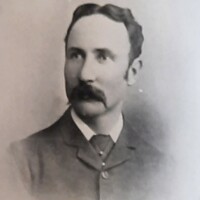 Philip Sandford, Professor of Latin
Philip Sandford, Professor of Latin Philip Sandford, born in Clonmel, son of a Church of Ireland clergyman, went to Trinity College Dublin where he distinguished himself in Classics, English and Metaphysics. Then, he spent some time in South Africa (Keaveney, 1999). He became Professor of Latin in Queens College Galway (Q.C.G.) in 1890. Some of his research publications are quoted by Keaveney. He was skilful in playing tennis, having being tennis champion in Natal, South Africa and became tennis champion at Q.C.G. as well. He was also a keen supporter and member of the Debating Society. He contracted rheumatic fever in July 1903 (Q.C.G. Magazine, 1903) and died on 2 Aug., of the same year, aged 48 years (irishgenealogy_1903). His obituary appeared in a Supplement to Q.C.G. magazine (Q.C.G., Nov.,1903). His picture is reproduced from that magazine issue.
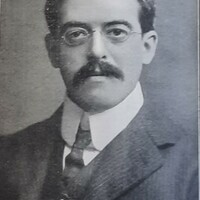 T. J. l’A. Bromwich, Professor of Mathematics
T. J. l’A. Bromwich, Professor of Mathematics Thomas John l’Anson (T.J. l’A.) Bromwich was educated in Durban High School, South Africa. He graduated from St. John’s College, Cambridge as senior Wrangler in 1895. He was appointed Chair of Mathematics in Queens College Galway (Q.C.G.) in January 1902 and had published some forty research papers by 1906 (Q.C.G. Magazine, 1906). His research was recognised through his election to a Fellowship of the Royal Society in the same year. His picture is reproduced from the Q.C.G. Magazine, 1906 issue. He resigned from Q.C.G. in 1907 to take up a Lectureship in St. John’s College, Cambridge (S. Tobin, 1999. He died by suicide in 1929.
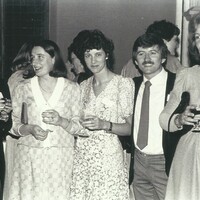 Administrative Staff Graduates' Reunion, 1985
Administrative Staff Graduates' Reunion, 1985 Administrative Staff Graduates attending their second annual reunion in the Aula Maxima in September 1985
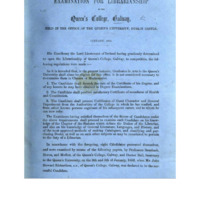 Examination for Librarianship, Queen's College, Galway, 1856
Examination for Librarianship, Queen's College, Galway, 1856 The four examination papers set for the post of Librarian in Queen's College, Galway, on 8 and 9 January 1856. Eight candidates took the examination. The successful candidate was 'Mr. John Howard Richardson, A.B., of Queen's College, Galway'. He was to hold the post from 1856 to 1877. During his time as Librarian he produced the first printed catalogue of the books held by the Library.
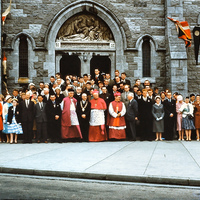 Pax Romana Congress, Galway, 1959
Pax Romana Congress, Galway, 1959 The two members of the Catholic hierarchy on either side of Mayor Peter Greene are, from left to right, Monsignor Pádraig de Brún, President of UCG (1945-1959), and Rt. Revd Dr Michael J. Browne, Bishop of Galway and Kilmacduagh (1937-1976). Near the back, 2nd from the left in the 2nd-last row, is Tom O'Connor, Lecturer in Physics.
The church behind the group is St. Joseph's Catholic Church on Presentation Road, recorded by the National Built Heritage Service as having been built in 1880-1885.
The Pax Romana has a graduate branch, the International Catholic Movement for Intellectual and Cultural Affairs (ICMICA-MIIC), and a student branch, the International Movement of Catholic Students (IMCS). A brief account of its development is provided on the website of the Newman Association (Lambert 2013).
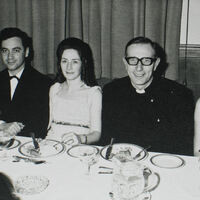 Science Dress Dance, 1970
Science Dress Dance, 1970 The people seen here are, from left to right: Mrs Mary O'Driscoll, Lady Superintendent; Frank Imbusch, Lecturer in Physics and later Professor; Mary Imbusch, née O'Donnell; Fr Tom (Pops) Kyne, Dean of Residence; and Daidin Ó hEocha, née Fahy.
The Deans of Residence, all men, were appointed to cater for the needs of students of various religious persuasions. After the Synod of Thurles (1850) forbidding Catholic clergymen to hold office in the Queen's Colleges, all Catholic Deans of Residence resigned. The result was anomalous. In 1899-1900 in Galway, for example, there were deans for members of the Church of Ireland, for Presbyterians and for Wesleyan Methodists, but none for Catholics. In the same year the religious persuasion of the student body was recorded as 15 Church of Ireland, 48 Roman Catholics, 41 Presbyterians, 4 Wesleyan Methodists, and 2 ‘Various’. (President’s Report, p. 9)
In the Irish Universities Act of 1908, the Statute for the university in Galway stipulated that there should be a Lady Superintendent and it set out her duties in detail (Chap. XXIV), as well as her remuneration and pension. It required all women students to 'enter under the Lady Superintendant'. By the time Mrs O'Driscoll was appointed, that rule does not seem to have been stringently enforced. Many graduates of the 60s and 70s recollect her with affection, as has been recorded by Jackie Uí Chionna (Oral History, 2019).
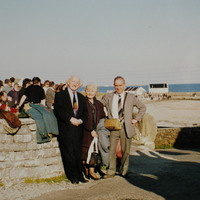 A fine day on Aran with Michael D. Higgins, April 1994
A fine day on Aran with Michael D. Higgins, April 1994 On the left is Michael D. Higgins, who was at the time Ireland’s first Minister for the Arts. In the middle is Mary Imbusch, née O'Donnell, and beside her is her husband Frank Imbusch, Professor of Physics. The photo was taken on Inishmore at the launch of 'The Book of Aran', an event which was attended by a large number of people living on the island, by staff from NUI Galway and notable political figures.
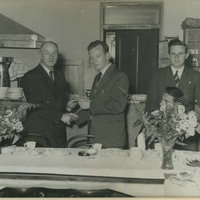 Mayor Greene at UCG
Mayor Greene at UCG The caption on this image in the University Archives is simply, 'Mayor Greene at UCG', with no information on the occasion, location, date or the persons shown. Peter Greene (1895-1963) was Mayor of Galway from 1954 to 1960; hence the image can be dated to that period of his as Mayor. He is the man standing on the left.
From the brief caption ('at UCG'), it can be deduced with confidence that the location was the kitchen area of the old Coffee Shop. That was the only location on campus at the time where staff and students could get tea and coffee.
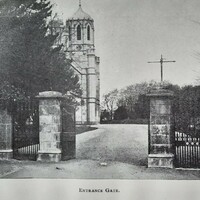 Entrance Gate to the University
Entrance Gate to the University The picture shows the entrance gate to the University, which is open. There is a mounting on top of the two central stone pillars. Smaller gates are positioned between the central and outer pillar on both sides of the entrance. The clock tower is visible in the background.
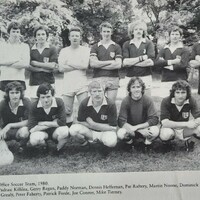 Buildings Office Soccer Team 1980
Buildings Office Soccer Team 1980 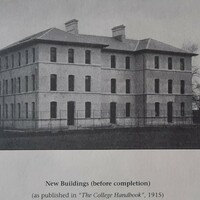 Engineering Building
Engineering Building The picture shows the incomplete Engineering Building (College Handbook, 1915). The Engineering building opened in 1914, containing the School of Civil and Electrical Engineering (Calendar, 1923).
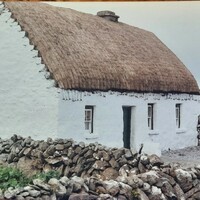 Ó FATHARTA, Pádraig
Ó FATHARTA, Pádraig 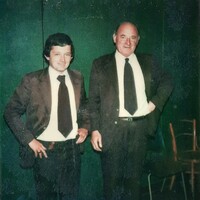 Some Porters from the 1970s to 1990s
Some Porters from the 1970s to 1990s Peter Faherty, following in the footsteps of his father, Pádraig Ó Fatharta, became a Porter at the University in 1973, during a period when Eamonn Canny was Head Porter, who took over from Pádraig Ó Fatharta in 1969. Peter was appointed Head Porter in 1977 at a relatively young age and performed his work along with colleagues in the Archway. He with fellow Porters moved out of the Archway in 2003. He remained in the post until 2005, when the post was officially terminated with Peter then becoming Supervisor of Facilities & Services in the North campus, under the aegis of the Buildings Office, before retiring in 2012. The first picture shows Padraig Ó Fatharta with his son Peter, taken in 1977, presumably at the time that Peter became Head Porter.
Some of the other Porters included Pat O’Reilly and Joe Devaney, brother of John who worked in the mail office. The second picture shows Pat O’Reilly, Porter, taken in the Porter’s Office in about 1991. The third picture shows Pater Faherty holding the University Mace at some academic conferring ceremony.
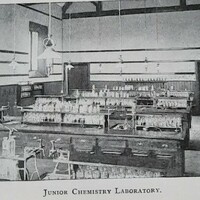 Earlier Laboratories
Earlier Laboratories Four Laboratories are described: Junior Chemistry; Junior Physics; Pathology; and Physiology. With the exception of the Pathology Laboratory, all were housed in the Main quadrangle building of the University. The Pathology Department was transferred to the side wing of the Civil & Electrical Engineering Building which was built in 1914 (Murray, 1999; Univ. Calendar, 1923-4). It was located on the top floor and consisted of three rooms – a museum, a student’s laboratory, and a research laboratory.
The ground floor of the east wing of the Main building housed the Chemistry Department, the Men’s Reading Room and the Greek Hall (originally called the Mechanical and Philosophical Theatre). In about 1932, the Chemistry Department moved to the Model School on Newcastle Road and was there until 1963 (Butler, 1999; O’Connor, 1999).
Space was allocated to the Department of Natural Philosophy / Physics soon after Prof. Anderson assumed the Chair in 1885 (O’Connor, 1999). A Physics Lecture Room, a museum and a laboratory were then housed on the ground floor of the south wing of the Main Building (O’Connor, 1999). It appears that the so-called Junior Physics Laboratory was towards the east of the southern wing, with the ‘non-Junior’ Laboratory [which is shown in Clancy, Jennings, Asset id 14222] towards the west.
The Department of Physiology was located on the first floor of the east side of the Main Building and consisted of three rooms - for experiments, histology work and physiological chemistry (Univ. Calendar 1923-4, p. 44).
Pictures of the four Laboratories were published in the College Handbook, 1915.
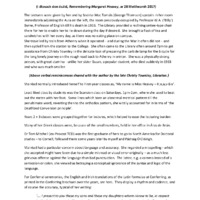 heavey
heavey 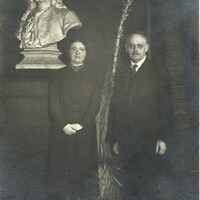 Máirín de Valéra, Lund, 1938
Máirín de Valéra, Lund, 1938 Máirín de Valéra (1912-84) pictured with the phycologist Harald Kylin (1879-1949) in Lund University in 1938, standing in front of a bust of the famous Swedish biologist Carl Linnaeus (1707-78), with a fossilised Equisetum between them. At that time, she was a student at Lund University , enrolling there in 1937 in pursuit of her postgraduate studies, with the support of the NUI Travelling Studentship awarded to her in 1936. She worked under the direction of Kylin and published several papers on algal morphology and physiology.
Máirín de Valéra spent her entire academic career at UCG, as Assistant in Botany (1939-47), Lecturer in Botany (1947-62) and finally as the first Professor of Botany (1962-78). She was elected a member of the Royal Irish Academy (1956). She was a co-founder of the British Phycological Society in 1951 and was elected Vice-President of the Society (1969) and later made a life member (1977).
Despite being the only botanist in the University for many years and her consequent very heavy teaching load, involving the teaching of all courses in the plant sciences through both English and Irish, she continued to pursue her prime research interests in phycology and, through her publications, acquired international recognition for her unequalled knowledge of the marine algae of the west coast of Ireland. Her unique contribution to the University was recognised by the naming, in 2006, in her honour of the Carron Field Research Facility, established by the University in 1975 as a base for research in the Burren; a commemorative plaque was unveiled there
on that occasion by Minister of State Síle de Valera, a niece of hers. The location for the Finavarra marine research field station in Co. Clare on the shores of Galway Bay, established by the University with funding from Clare Co. Council, was also chosen by her.
Johann Harald Kylin was Professor of Botany in Lund University (1920-44) and a renowned phycologist, specialising in the marine algae of the west coast of Sweden.
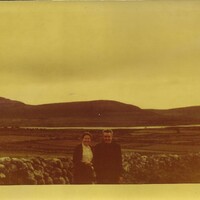 Máirín de Valéra near Finavarra
Máirín de Valéra near Finavarra Dr Máirín de Valéra with Fr J.H. Mullahy, SJ in July 1952 'not far from Finevarra'.
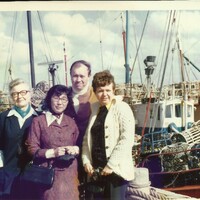 Máirín de Valéra in Roscoff, 1976
Máirín de Valéra in Roscoff, 1976 Máirín de Valéra with fellow phycologists in the fishing port Port de Moguériec, Roscoff, Brittany in May 1976
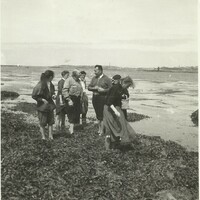 Máirín de Valéra i Roscoff, 1954
Máirín de Valéra i Roscoff, 1954 Dr Máirín de Valéra with fellow phycologists viewing and collecting samples of algae from the seashore in Roscoff, Brittany in 1954
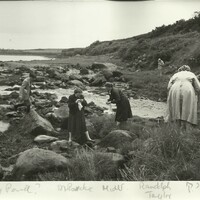 Máirín de Valéra and others collecting marine algae samples
Máirín de Valéra and others collecting marine algae samples Máirín de Valéra and fellow phycologists collecting samples of marine algae from a rocky seashore site
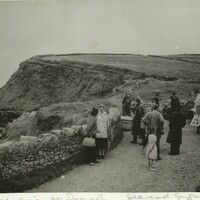 Máirín de Valéra - excursion to Roonagh, 1958
Máirín de Valéra - excursion to Roonagh, 1958 This was an excursion to Clew Bay, with shore collecting, as part of the third International Seaweed Symposium held in the University on August 13-19, 1958. The words, 'Excursion to Roonagh' are pencilled in at the foot, although the words 'Spanish Point 18.8.58' appear on the back; the programme also included an excursion to Spanish Point for 'shore collecting at Miltown Malbay, Co. Clare'. The programme was divided between Botany, Chemistry and Utilisation sections.
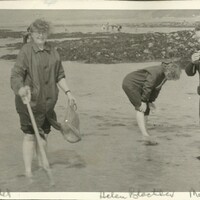 Máirín de Valéra collecting samples on seashore
Máirín de Valéra collecting samples on seashore Máirín de Valéra and two fellow phycologists collecting marine samples on a seashore, with other groups apparently similarly engaged in the background
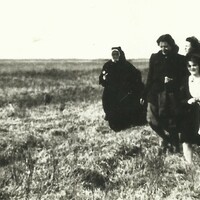 Máirín de Valéra's Botany students on a fieldwork outing in a bog, 1940s
Máirín de Valéra's Botany students on a fieldwork outing in a bog, 1940s Eleven female Botany students , two of them nuns, on a fieldwork outing in a bog, with a bank of turf in the distance. Two of them are holding a flower, probably bogcotton. The location is most likely a bog in Connemara. The photograph was probably taken by Máirín de Valéra herself, as she is not readily identifiable therein.
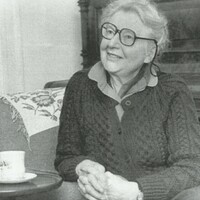 Máirín de Valéra ag baile, 1983
Máirín de Valéra ag baile, 1983 Máirín de Valéra photographed during an Irish Press interview at her home in Galway in 1983
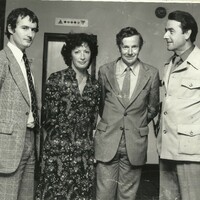 Dorothy Fox, Dioraí Ó Coirbhin agus beirt eile
Dorothy Fox, Dioraí Ó Coirbhin agus beirt eile Dorothy Fox standing with Dioraí Ó Coirbhin (extreme right) and two other unidentified men in what seems to be a hotel lobby. Dorothy Fox was Secretary to Dioraí Ó Coirbhin (Rúnaí-Sparánaí /Secretary-Bursar, 1966-90) in the 1970s-1980s.